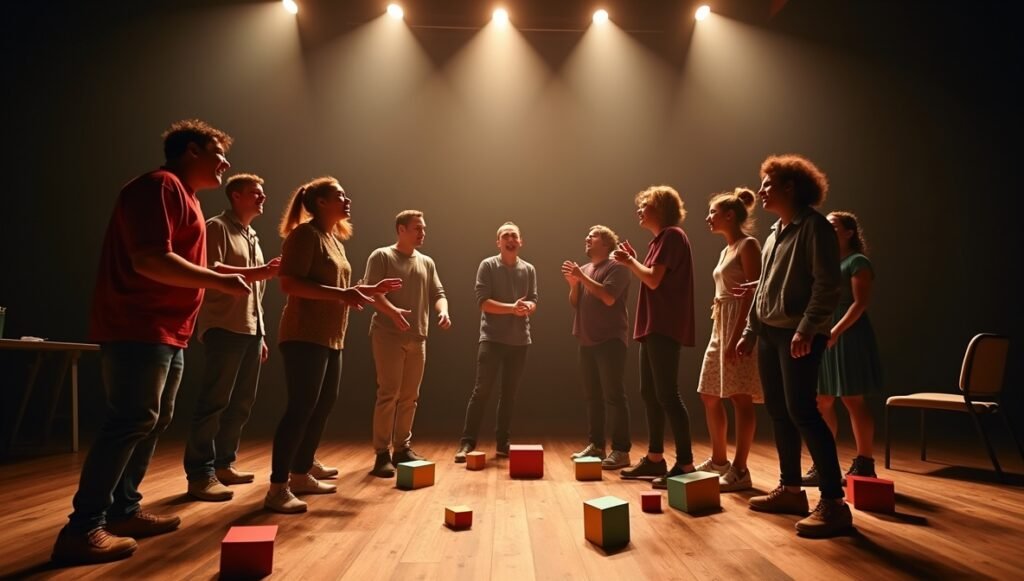Improvisation is the heartbeat of acting. It trains performers to listen deeply, respond truthfully in the moment, and turn uncertainty into discovery. Whether you run a professional conservatory or casually coach a student troupe, adding structured improv games to rehearsal sharpens timing, fosters trust, and frees performers from the fear of “getting it wrong.”
Below you’ll find 20 field-tested games, each with clear objectives, practical steps, and quick-fire variations. Every entry includes two concise paragraphs of guidance followed by bite-sized tips you can reference on the studio floor. Mix and match them to design warm-ups, full workshop sessions, or audition room ice-breakers.
1. Zip Zap Zop
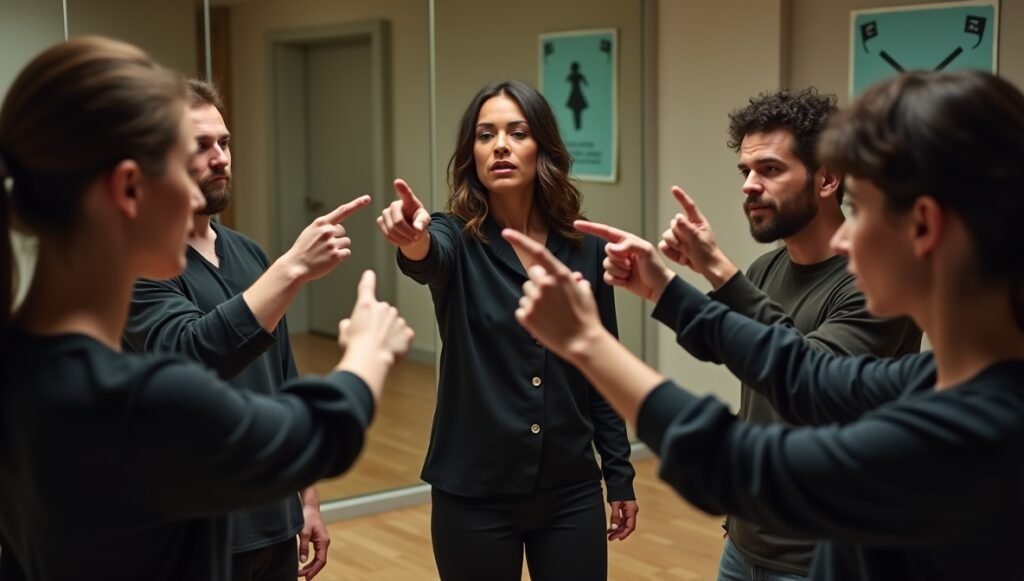
Zip Zap Zop is a classic warm-up that wakes up reflexes and ensemble focus. Players stand in a circle and pass an imaginary energy bolt by pointing and saying “Zip,” “Zap,” or “Zop” in strict sequence. The rhythmic hand-to-eye coordination forces actors to stay present and anticipate patterns together, creating a shared pulse before heavier scene work.
Because the word chain is predictable, the game highlights micro-hesitations. Breaking the sequence—using the wrong word or losing eye contact—resets the round and reminds actors that listening matters as much as speaking. Once the circle flows smoothly, speed up the tempo or add a fourth word to disrupt comfort zones.
- Group Size: 6 – 20
- Primary Skills: Focus, rapid decision-making
- Variation: Play “Zip Zap Zop & Stop” where anyone can silently fake a send, forcing sharper observation.
- Coaching Cue: Encourage players to breathe out on each word to keep diction crisp.
2. Yes-And Circle

“Yes-and” is the golden rule of improv: accept an offer and add to it. In a circle, each player contributes one statement beginning with “Yes, and…”. The collective builds a spontaneous narrative, reinforcing that nothing kills creativity faster than denial.
The facilitator listens for hidden blocks (“Yes, but…”) and steers the group back on course. Over time, participants learn to trust incomplete ideas, knowing teammates will make them whole. The exercise is a gateway to more complex scene work that requires agreement under pressure.
- Group Size: 4 – 15
- Primary Skills: Agreement, collaborative storytelling
- Variation: Ban all adjectives for a round to force imaginative nouns and verbs.
- Coaching Cue: Praise bold offers; discourage hedging language like “maybe.”
3. One-Word Story

Players sit or stand in a line and create a story one word at a time. The constraint dismantles over-planning, compelling actors to accept whatever emerges. Rhythm is key—an even tempo prevents self-editing and pushes instinct to the forefront.
After a few sentences, you’ll see group tempo rise and dip in waves. That cadence reveals leadership shifts and subconscious theme building, giving directors insight into ensemble chemistry without formal scene analysis.
- Group Size: 3 – 12
- Primary Skills: Listening, narrative rhythm
- Variation: Impose genre (“noir,” “fairy tale”) to test stylistic vocabulary.
- Coaching Cue: If someone stalls, have the next person supply two quick words to rescue momentum.
4. Props Grab-Bag
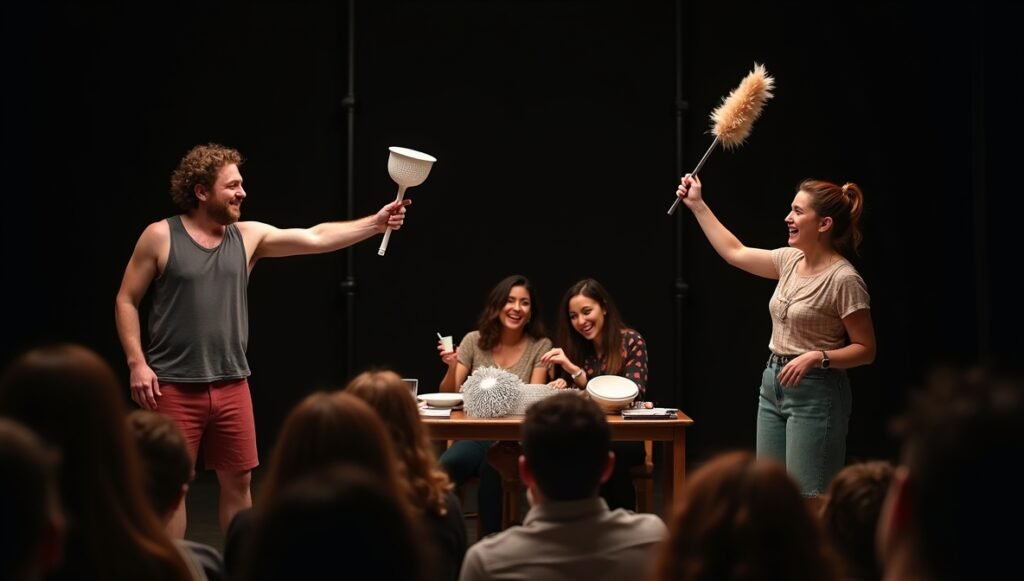
Fill a tote with random household items. In pairs, actors pull one prop each and must justify its imaginative use in a short scene. Objects become metaphors, weapons, or magical devices depending on context, training performers to assign meaning fast.
Because the prop dictates physical choices, the game roots imagination in tactile reality. It’s especially valuable for on-camera actors who must interact believably with set dressing that’s new to them on shoot day.
- Group Size: 4 – 20 (pairs or trios)
- Primary Skills: Object work, spontaneous justification
- Variation: Set a time limit of 30 seconds before dialogue begins to force swift commitment.
- Coaching Cue: Celebrate unconventional uses over comic clichés.
5. Party Quirks

One actor plays host; three others arrive with secret quirks or identities written on slips of paper. The host mingles and must guess each guest’s quirk through conversation. The tension between hidden information and discovery produces rich subtext and clear status shifts.
Actors portraying quirks explore specificity: how does an alien tourist differ from a sleep-walking novelist? Meanwhile, the host practices active observation and layered questioning without derailing flow—skills transferable to scripted scene analysis.
- Group Size: 4 – 8
- Primary Skills: Character commitment, status dynamics
- Variation: Assign non-human quirks (e.g., “camera drone with low battery”) to boost physical choice-making.
- Coaching Cue: Instruct guests to reveal quirks gradually; avoid blunt exposition.
6. Freeze Tag
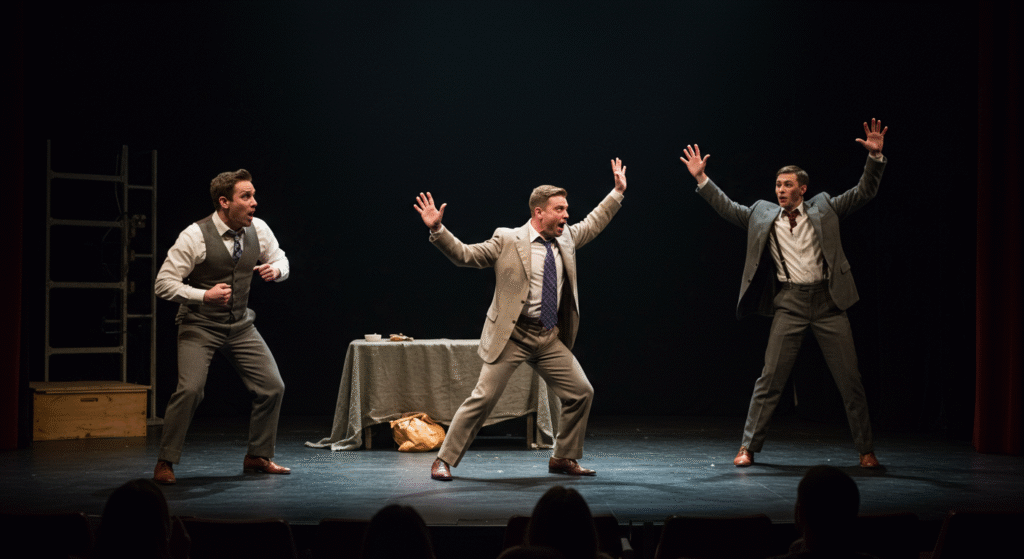
Two actors start an open scene. At any point, someone yells “Freeze!”, taps a performer, mirrors their exact posture, and starts a brand-new scene that justifies the pose. The constant reboot trains bodies and brains to shift context mid-gesture.
Because choices must honor the frozen shape, players discover fresh scene premises quickly—perfect rehearsal for auditions where cold reading demands instant given-circumstance invention.
- Group Size: 6 – 15
- Primary Skills: Physical spontaneity, transformational thinking
- Variation: Allow only silent scenes for one round to sharpen non-verbal storytelling.
- Coaching Cue: Keep “freeze” calls rapid; hesitation dulls the energy spike.
7. Alphabet Game

Partners improvise dialogue, each line starting with the next letter of the alphabet (“A – B – C…”). The letter rule provides external pressure, preventing comfortable fallback phrasing and highlighting linguistic agility.
As stakes rise, actors discover emotional nuance while scanning vocabulary. Encourage them to prioritize truthful reactions over clever word choices—authenticity beats alphabet gymnastics every time.
- Group Size: 2 per scene
- Primary Skills: Verbal agility, emotional continuity
- Variation: Begin at a random mid-alphabet letter to avert rehearsed openings.
- Coaching Cue: If a letter stumps someone, allow a beat of silent eye contact instead of breaking flow.
8. Emotional Switch

Two performers play a neutral scene. At intervals, a coach calls out an emotion (“joy,” “fear,” “envy”). Actors must continue dialogue while fully adopting the new feeling. The exercise separates text from subtext, illustrating how shifting inner life reframes identical words.
It also teaches emotional availability on cue—vital for film sets where camera resets require instant re-entry into high-stakes moments.
- Group Size: 2 – 6 performers per round
- Primary Skills: Emotional agility, subtext layering
- Variation: Let fellow students shout emotions to involve the whole room.
- Coaching Cue: Urge players to lead with breath and posture, then let voice follow.
9. Gibberish Interpreter
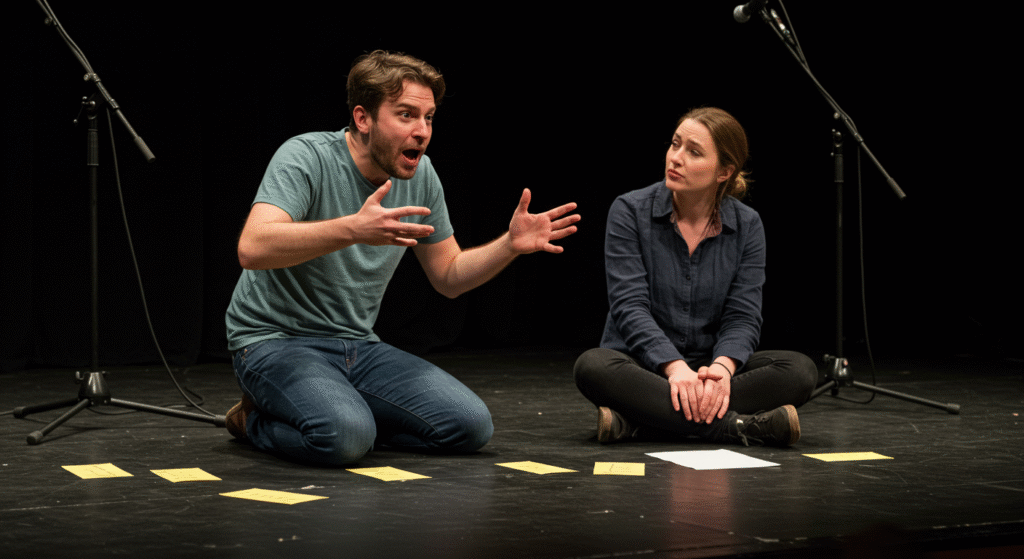
Actor A speaks in gibberish while Actor B “interprets” the nonsense into English for the audience. The real story emerges from tone, gesture, and timing, proving that communication is 80 percent non-verbal.
For Actor B, paraphrasing intent without contradicting signals trains deep listening. Actor A practices commitment to vocal texture and rhythm, freeing them from over-reliance on literal words.
- Group Size: Pairs
- Primary Skills: Non-verbal clarity, active listening
- Variation: Swap roles mid-scene to test adaptability.
- Coaching Cue: Discourage comedians from inventing easy punch lines; focus on relationship stakes.
10. Status Cards
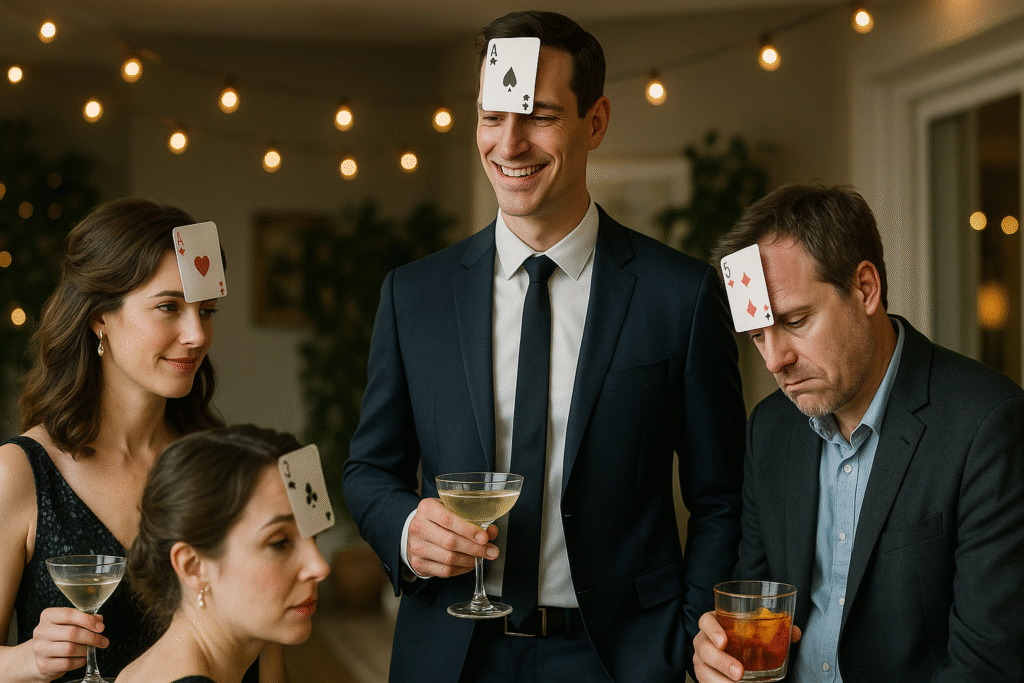
Each player draws a card (Ace high, Two low) without looking and pins it to their forehead. Actors mingle at an improvised cocktail party, treating others according to perceived status. After five minutes, they guess their own rank.
The game unpacks social hierarchies and physical cues: higher status characters often take space, maintain eye contact, and initiate topics. Lower status ones shrink, laugh nervously, or echo others’ language.
- Group Size: 8 – 20
- Primary Skills: Status awareness, physical characterization
- Variation: Use themed ranks (royalty pecking order, corporate ladder) for genre rehearsals.
- Coaching Cue: Debrief afterward on subtle behaviors that signaled rank.
11. Story Dice Relay
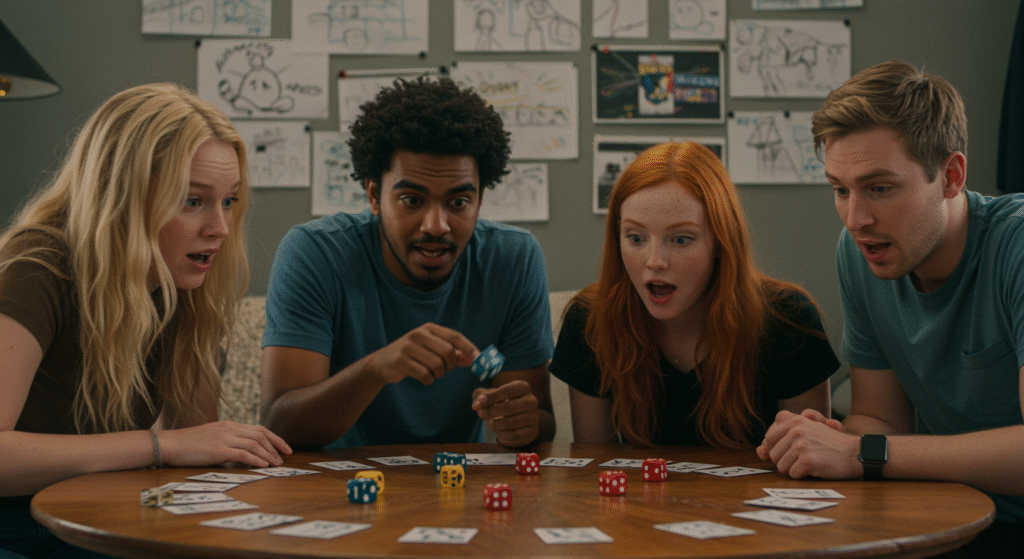
Give each player a picture die (or virtual image prompt). One by one, they reveal their die and add a sentence connecting the new image to the evolving tale. The physical cue injects unexpected twists and cures writer’s-room block in ensemble‐devised scripts.
Because no one controls the dice outcome, participants practice embracing randomness—a muscle that serves when line cuts or director notes shift a scene’s direction mid-shoot.
- Group Size: 4 – 12
- Primary Skills: Narrative flexibility, ensemble building
- Variation: Roll two dice at once and choose only one image to heighten selectivity.
- Coaching Cue: Encourage callbacks to earlier images to weave thematic cohesion.
12. Space Jump

Four actors perform mini-scenes, each building on the last. Actor 1 starts alone; “Space Jump!” is called, freezing the pose. Actor 2 enters, touches the pose, and transforms it into a new reality. Repeat until four actors fill the stage, then reverse—actors exit in last-in-first-out order, each time snapping back to previous scenes.
The ping-pong between contexts tests memory, commitment, and muscular recall. By the final rewind, players must reproduce original rhythms under fatigue, mirroring the endurance needed for long-form theater runs.
- Group Size: 4 exactly per round
- Primary Skills: Scene stacking, rapid transformation
- Variation: Add a theme (holiday, apocalypse) to tighten narrative threads.
- Coaching Cue: Remind performers to maintain initial staging so rewind beats land accurately.
13. Conducted Story
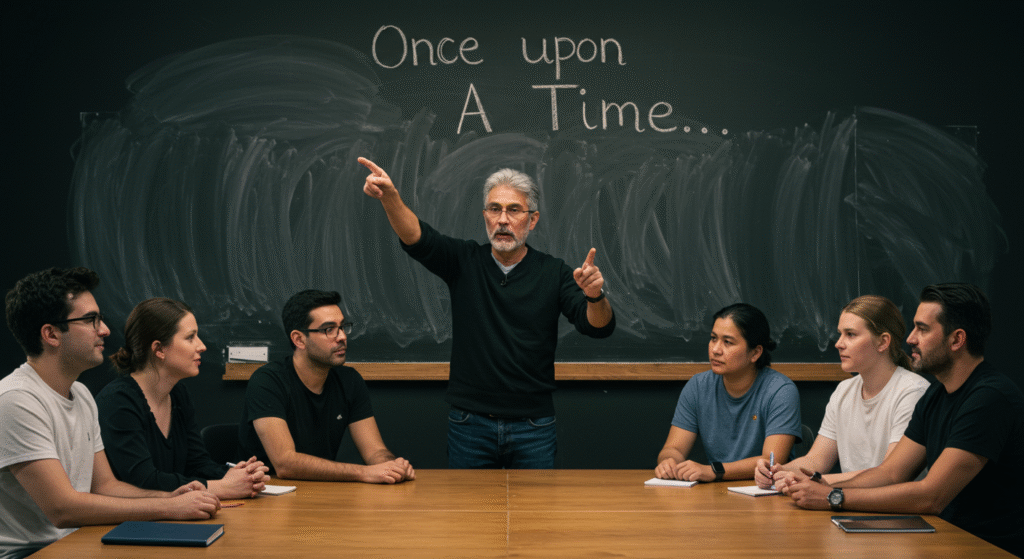
A conductor points to players in sequence, and each must continue a single story aloud until the conductor points elsewhere. Sudden hand-offs prevent mental scripting and highlight the collective mind of the ensemble.
Mistakes—contradictions, dropped threads—become opportunities for inventive justification. The conduit role teaches directors how to steer without micromanaging, while storytellers learn to release authorial ego.
- Group Size: 5 – 10
- Primary Skills: Narrative continuity, shared ownership
- Variation: Allow the conductor to change tempo (slow-motion speech, fast-forward).
- Coaching Cue: Push for descriptive verbs and sensory detail; avoid passive filler.
14. Expert Interview
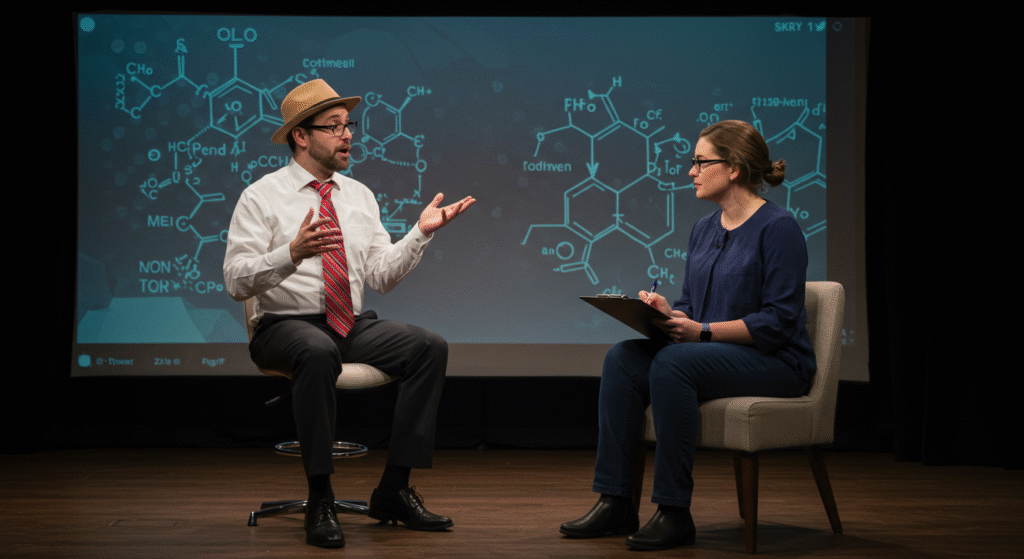
One performer is declared a world-famous expert on a ridiculous topic (“submarine gardening,” “glow-in-the-dark sheep”). An interviewer asks probing questions, and the expert must answer with authority. Inventing jargon trains verbal confidence; asking follow-ups tests logical consistency.
Audiences love watching holes in explanations patched on the fly. For actors, the exercise rehearses press-junket composure and character point of view under scrutiny.
- Group Size: 2
- Primary Skills: Character intellect, comedic justification
- Variation: Add a third person interpreting for a newscast, layering stakes.
- Coaching Cue: Interviewer should probe gently at first, then escalate to expose contradictions.
15. Slide Show

Using an unseen slide deck, one actor clicks an imaginary remote while another “explains” each projected image. At random intervals, the presenter must pivot topics, mirroring corporate keynote chaos. The game blends mime with verbal dexterity, reinforcing calm adaptation when tech fails in real auditions or stage shows.
Physicality matters: clicking, pointing, adjusting glasses—these tiny rituals sell the illusion of slides. Meanwhile, the speaker practices structuring points (premise, example, takeaway) on the fly.
- Group Size: 2 – 4 (rotating)
- Primary Skills: Mime accuracy, persuasive speech
- Variation: Let audience suggest each slide title for added unpredictability.
- Coaching Cue: Praise strong opening hooks; discourage “uh” crutches.
16. Character Bus Stop
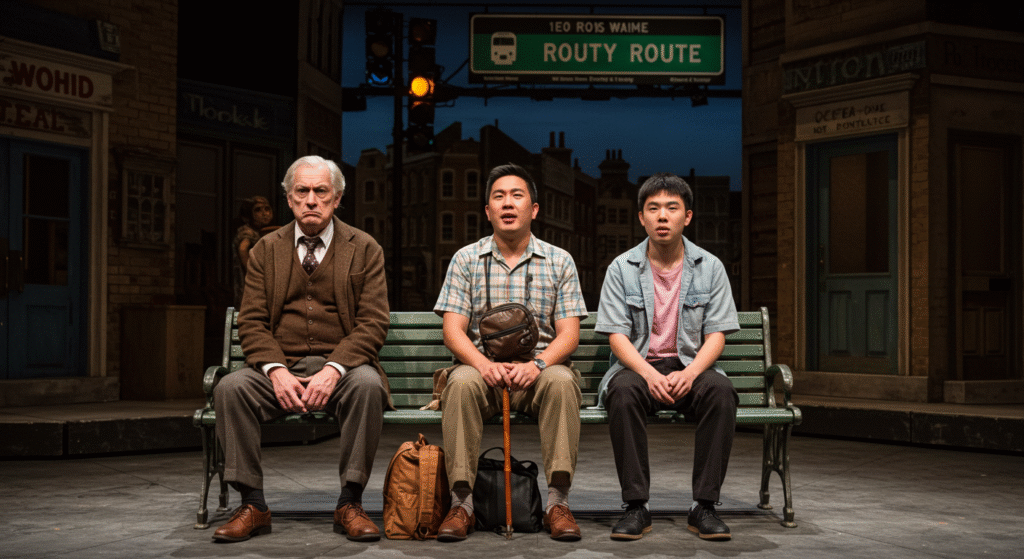
Three chairs form a bus-stop bench. Actors enter one by one with vivid characters (age, physicality, vocal tone). When the bench fills, the first rider “catches the bus” and exits, making room for a new personality. The revolving door keeps interactions fresh and spotlights contrasting energies.
Because time on the bench is limited, performers focus on concise objectives and bold initiation—ideal practice for callback auditions demanding quick character reveals.
- Group Size: 3 – 10, overlapping
- Primary Skills: Character work, objective clarity
- Variation: Assign emotional states rather than biographies to foreground inner life.
- Coaching Cue: Discourage instant monologues; lean into shared activity (checking phone, reading map).
17. Genre Replay

Actors perform a 90-second scene. Then the director calls out a film or TV genre—western, sci-fi, telenovela—and the same scene is replayed in that style. Repetition sets a control baseline, allowing performers to exaggerate tropes without losing narrative spine.
The drill cultivates adaptability and awareness of stylistic conventions like blocking angles or vocabulary, essential skills for auditioning across diverse productions.
- Group Size: 3 – 6
- Primary Skills: Stylistic versatility, comedic contrast
- Variation: Replay in contrasting emotional tones (melodrama, documentary monotone).
- Coaching Cue: Keep original scene beats intact; only genre lens should shift.
18. New Choice (Ding!)

Two actors play a scene. Whenever the coach rings a bell or yells “New choice!”, the actor who just spoke must instantly replace their line with a fresh offer. The same cue applied after physical actions requires new gestures. It’s a crash course in non-attachment to first ideas.
Rapid rewrites reveal hidden comedic angles and train resilience when directors request alternate takes on set. Over time, performers learn that the first choice is rarely the only choice.
- Group Size: 2 at a time
- Primary Skills: Idea generation, flexibility
- Variation: Let fellow actors shout “New emotion!” for subtext shifts instead of line changes.
- Coaching Cue: Stop scenes that devolve into randomness; remind players to maintain story logic.
19. Sound Effects

One actor performs a silent task (fixing a sink, defusing a bomb) while another provides all accompanying sound effects from offstage. Success depends on timing: actor and foley artist must sync intuitively, illustrating partnership between on-camera talent and post-production teams.
The exercise heightens physical precision—each tool pick-up or door slam must be clear enough for a teammate to interpret. Likewise, the foley artist hones listening acuity and dynamic vocal control.
- Group Size: Pairs or rotating trio
- Primary Skills: Physical clarity, auditory imagination
- Variation: Reverse roles mid-scene without stopping.
- Coaching Cue: Encourage Foley performers to add ambient noises (creaking floor, dripping tap) to deepen realism.
20. Shakespearean Switch
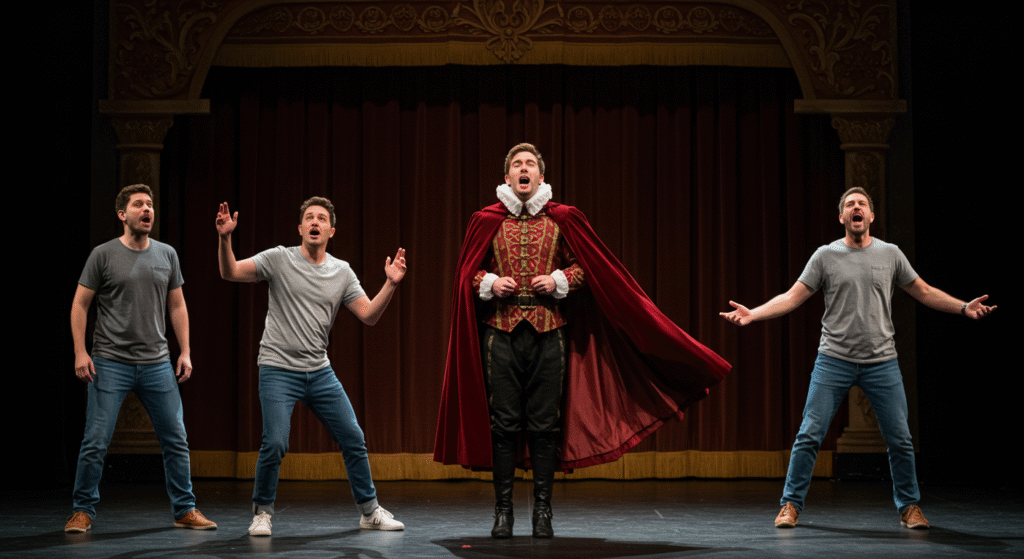
Actors improvise a modern scene but must periodically translate their last line into heightened Elizabethan verse. The cognitive jump between colloquial and poetic language sharpens linguistic range and breath control.
The switch underscores that style need not hinder spontaneity; it can amplify stakes when mastered. Classical audition material benefits directly from the heightened awareness of meter and imagery fostered here.
- Group Size: 2 – 4
- Primary Skills: Language dexterity, breath work
- Variation: Swap Shakespeare for another heightened style (Biblical prose, corporate jargon).
- Coaching Cue: Insist on clear imagery over forced archaic vocabulary.
Conclusion
Improv is more than comic relief between line drills—it’s a lab where actors discover emotional truth, ensemble trust, and the courage to risk failure.
Integrating these 20 games into your curriculum equips performers with practical tools for auditions, rehearsals, and live shows. Rotate warm-ups, escalate difficulty, and encourage post-game reflection so lessons carry into scripted work.
Most importantly, protect a judgment-free atmosphere; creativity thrives where experimentation feels safe. Treat every misstep as data, not error, and you’ll cultivate artists who leap boldly into the unknown—onstage and off.

